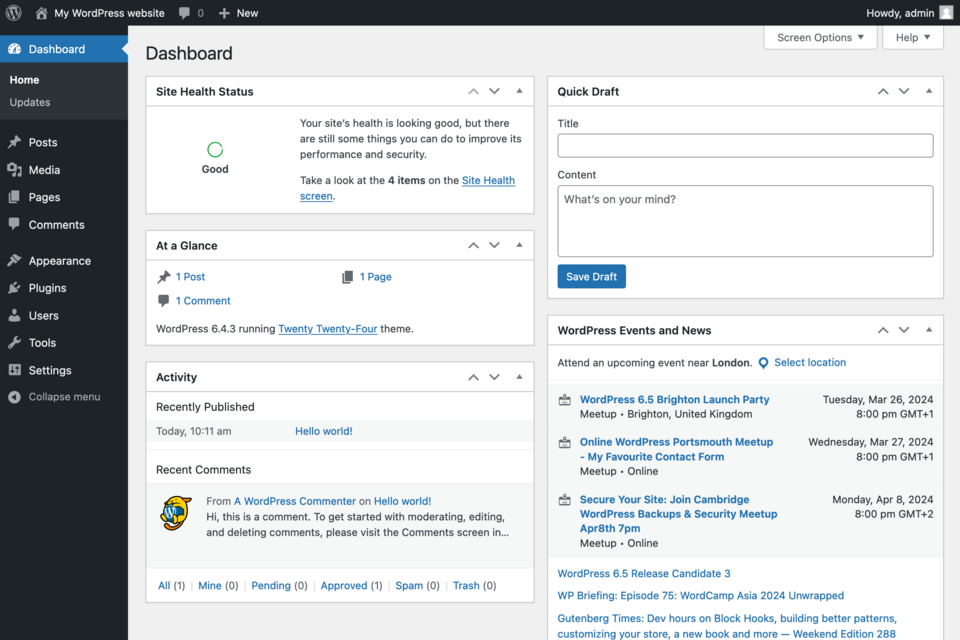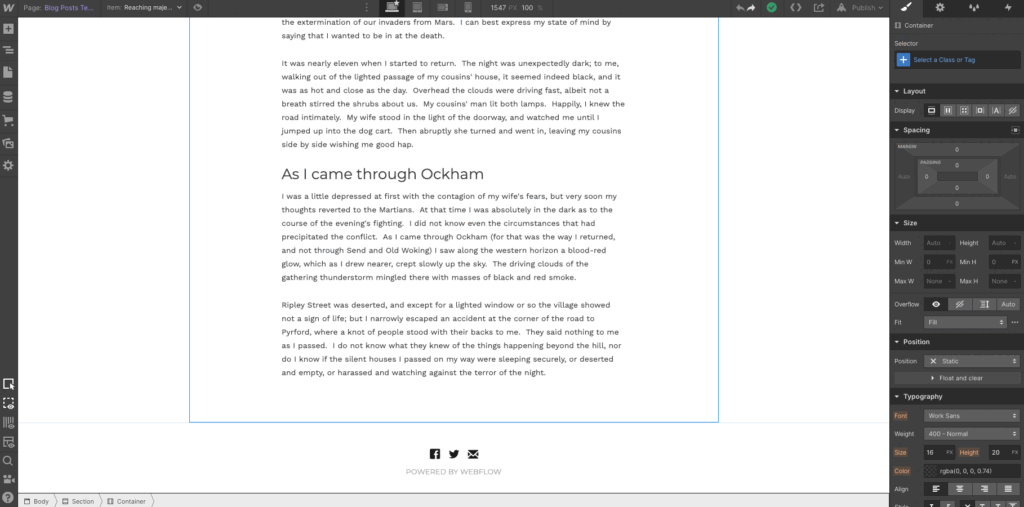Building a website is no longer a luxury; it is an expectation. Whether you’re starting a business, presenting your creative work, maintaining a blog, or developing an eCommerce brand, the question isn’t whether you’ll build a website, but which platform you’ll use.
And that leads us to two of the most dominant players in the space: Webflow and WordPress.
One is sleek, visual, and modern.
The other is powerful, flexible, and battle-tested.
Both can help you build beautiful websites — but they do it in very different ways.
In a digital landscape that has evolved dramatically over the past decade, we must ask which platform truly wins in 2025. Let’s take a human-centered, full-spectrum look at what each platform offers — and which might be the better fit for your goals.
A Quick Overview: What Are They Really?
WordPress (Classic Power)
Launched in 2003, WordPress powers over 40% of the internet. It’s open-source, endlessly customizable, and supported by a massive ecosystem of themes, plugins, and developers. Whether you’re creating a blog, an eCommerce store, a membership site, or a full-on media hub — WordPress can handle it. But it requires some technical knowledge and, often, a developer’s help.
Webflow (Modern Elegance)
Webflow is a visual web design platform launched in 2013 that is designed for people who want to build responsive, dynamic websites — without writing code. It’s beloved by designers, startups, and creative professionals who want full control over layout, animation, and branding. It’s more recent, more visual, and less reliant on plugins.
Design Freedom and User Interface
Webflow Wins on Design Precision
If your top priority is complete visual control, Webflow is the clear winner. It’s essentially Photoshop meets front-end development. Every pixel, animation, and layout shift is under your command. Designers love it because they can translate Figma-style layouts directly into real websites—with no developers needed.
- Clean visual canvas
- True CSS grid and Flexbox control
- Seamless animations and transitions
- No bloated theme limitations
WordPress is Template-Based — But Flexible
With WordPress, you’ll likely choose a theme or use a builder like Elementor. While these offer flexibility, you’re still working within predefined structures. You can get close to custom design, but often with extra plugins, third-party themes, or hand-coded tweaks.

Ease of Use (Especially for Beginners)
Webflow Has a Learning Curve — But a Friendly One
Although Webflow may not seem straightforward initially, it becomes intuitive once you comprehend the functioning of websites. If you’ve used design tools before, Webflow will feel logical. However, if you’re unfamiliar with layout systems such as Flexbox, margins, and containers, you may encounter a learning curve.
WordPress is Easier to Get Started With
WordPress is more beginner-friendly — especially with managed hosting providers like Bluehost, SiteGround, or WordPress.com. You can get up and running fast using a pre-made theme. However, how do you customize it? That’s where it gets tricky and plugin-dependent.
Content Management & Blogging
WordPress Is Still the Blog King
Let’s give credit where it’s due: WordPress is unbeatable for content-heavy sites. The platform’s original purpose was to facilitate blogging, and it continues to excel in this regard. With categories, tags, SEO plugins, and powerful publishing workflows, it’s still the best choice for serious publishers.
Webflow’s CMS Is Elegant — But Less Robust
Webflow’s CMS is ideal for smaller content models—blogs, case studies, and portfolios—and it’s highly customizable. However, when it comes to large-scale publishing, you might encounter certain limitations such as the lack of native content archiving and the absence of multi-author permissions.

Plugins and Extensibility
WordPress Is the Plugin Playground
With over 60,000 plugins, WordPress can be anything you want — if you can find the right tools and keep them maintained. Whether it’s SEO, eCommerce, memberships, forums, or booking systems, there’s likely a plugin for it.
But that power comes with baggage:
- Plugin conflicts
- Frequent updates
- Security vulnerabilities
- Performance issues if not optimized
Webflow Keeps It Clean
Webflow doesn’t rely on plugins. Everything from animations to forms to CMS to eCommerce is native. That means fewer updates, fewer compatibility issues, and smoother performance. But it also means you’re limited to what Webflow offers — unless you add code manually or integrate it with third-party tools.
SEO and Performance
SEO: WordPress Wins on Control, Webflow Wins on Clean Code
WordPress offers full control over SEO with plugins like Yoast or Rank Math. You can edit meta tags, schema, and sitemap structures easily.
Webflow, however, generates cleaner code, is faster by default, and has built-in SEO tools. It lacks some of the advanced SEO plugins that WordPress offers — but for most sites, Webflow is more than sufficient.
eCommerce Capabilities
WordPress (via WooCommerce) = Power + Complexity
WooCommerce is powerful, free, and deeply integrated into WordPress. It supports everything from physical products to subscriptions and memberships. But it requires plugins, payment integrations, hosting, and maintenance.
Webflow eCommerce = Simplicity + Design
Webflow offers beautifully designed, fully integrated eCommerce — but it’s not yet ideal for large catalogs, complex variants, or international logistics. Is it suitable for boutique or creative stores? It’s fantastic. Is it suitable for large-scale retail? WordPress or Shopify may be better.
Security, Hosting, and Maintenance
Webflow Takes Care of Everything
Webflow hosts your site on AWS and Fastly CDN. You get SSL, automatic backups, version history, and blazing-fast global delivery. There is no need for any maintenance. No worries.
WordPress Requires Vigilance
Security depends on your hosting, plugins, and practices. You will need to oversee backups, updates, caching, firewalls, and SSL, or consider hiring someone to handle these tasks. Despite its power, WordPress requires ongoing maintenance.
| Feature | WordPress | Webflow |
|---|---|---|
| Founded | 2003 | 2013 |
| Type | Open-source CMS | Visual no-code/low-code platform |
| Ease of Use | Beginner-friendly with themes, but can get complex with customizations | Moderate learning curve, intuitive for designers |
| Design Flexibility | Depends on themes/builders like Elementor | Full visual control, pixel-perfect layouts |
| Customization | Highly customizable via plugins, themes, and custom code | Highly customizable through native tools and custom code |
| Content Management | Powerful CMS ideal for blogs, news, and multi-author sites | Strong CMS, best for collections and simpler publishing workflows |
| Plugins & Extensions | 60,000+ plugins for almost any feature | No plugin store, relies on native features or embeds |
| SEO Capabilities | Excellent, especially with plugins like Yoast or RankMath | Clean code, fast performance, built-in SEO tools |
| eCommerce Support | WooCommerce integration (advanced and scalable) | Native eCommerce (clean and visual, but less flexible) |
| Hosting | Free core + hosting + plugins/themes (can range from $5 to $5–$100+/mo) | Hosting included (AWS + CDN, highly optimized) |
| Security | Varies by host and plugins, requires management | Secure by default, SSL, backups, updates managed |
| Mobile Responsiveness | Depends on theme responsiveness and plugins | Built-in responsive design tools |
| Performance | Depends on hosting and plugin setup | Fast by default, minimal code bloat |
| Cost | Free core + hosting + plugins/themes (can range $5–$100+/mo) | Paid plans ($14–$212/mo, includes hosting and CMS) |
| Developer Access | Full access to backend, PHP, MySQL | Front-end code export, limited backend access |
| Best For | Blogs, large content sites, marketplaces, enterprise | Designers, creatives, startups, landing pages, agency sites |
| Learning Curve | Easy to start, but deeper customizations require technical skill | Higher upfront learning curve, but more intuitive for design pros |
| Community & Support | Massive global community, extensive documentation and tutorials | Smaller, fast-growing community with high-quality learning resources |
| Maintenance | Regular updates, plugin/theme conflicts possible | Little to no maintenance, managed by Webflow |
| Multi-language Support | Available via plugins (e.g., WPML, Polylang) | Built-in support via Webflow Localization (launched 2023) |
| Ownership & Portability | Full ownership of files and hosting | Platform-dependent, code export available |
Pricing Comparison (2025)
Webflow
- Free for testing, but not usable for a custom domain
- Basic Site Plan: ~$14/month
- CMS Plan: ~$23/month
- Business/eCommerce: $39–$212/month
- Hosting is included
WordPress
- Free open-source core
- Domain: ~$10–$15/year
- Hosting: ~$5–$30/month (shared to managed)
- Premium themes/plugins: Optional but often necessary
Verdict: Webflow is slightly more expensive upfront but includes hosting and fewer add-ons. WordPress can be cheaper—or much more expensive—depending on how you scale.
Final Verdict: Who Wins in 2025?
It depends on what you’re building.
| Use Case | Winner |
|---|---|
| Designer portfolio | Webflow |
| Custom brand website | Webflow |
| Blog or media site | WordPress |
| Massive eCommerce store | WordPress |
| Boutique online shop | Webflow |
| Content-heavy publishing platform | WordPress |
| Marketing site with animations | Webflow |
| Membership or subscription business | WordPress |
| Set-it-and-forget-it website | Webflow |
In 2025, both Webflow and WordPress are powerful in their ways. It’s no longer about which platform is “better.” It’s about which one aligns with your priorities, your team’s skill set, and your growth strategy.
- If you want creative freedom, a modern interface, and low maintenance, Webflow is a dream.
- If you require complete extensibility, rich content tools, and large-scale flexibility, WordPress continues to be a powerful platform.
The best platform is the one that helps you bring your ideas to life — beautifully, efficiently, and sustainably.




















